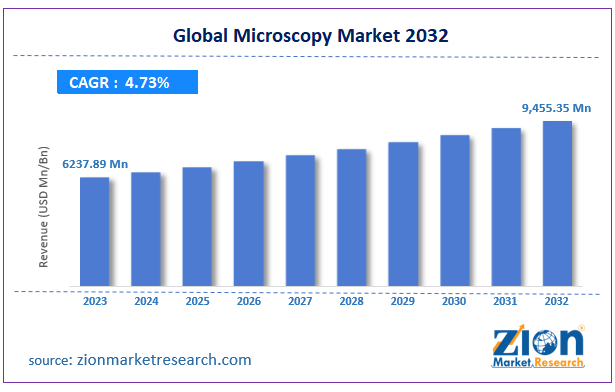Microscopy Market Size, Share, Trends, Growth 2032

The size of the global microscopy market was estimated to be about USD 6237.89 million in 2024, and it is expected to increase at a compound yearly growth rate (CAGR) of roughly 4.73% between 2024 and 2032 to be around USD 9,455.35 million.
✈👉Get a Free Sample: 🚀https://www.zionmarketresearch.com/sample/microscopy-market
Introduction
The microscopy market has witnessed remarkable advancements in recent years, fueled by breakthroughs in technology, the growing need for high-resolution imaging across various fields, and the expansion of research in life sciences, materials science, and nanotechnology. Microscopy plays a pivotal role in scientific research, medical diagnostics, and industrial applications, enabling researchers and professionals to study structures at micro and nano scales. As the demand for advanced imaging solutions grows, the microscopy market is projected to expand significantly in the coming years.

Overview of the Global Microscopy Market
The global microscopy market is experiencing steady growth, with a forecasted compound annual growth rate (CAGR) of XX% from 2024 to 2030. The market’s value, estimated at $X billion in 2023, is expected to surpass $X billion by 2030. The rising demand for microscopy in biomedical research, pharmaceuticals, material science, and nanotechnology, along with innovations in digital and automated microscopy, are driving this growth.
The field of technical science known as microscopy is dedicated to the study, enlargement, and observation of objects that are invisible to the human eye. The study of microscopy can be further divided into optical, electron, and scanning probe microscopy. It is recognised as the science of utilising a tool called microscope to analyse an object’s nature, traits, and structure. Numerous biological and chemical studies depend heavily on the use of microscopes. It is widely used in research facilities, life science institutes, and the semiconductor industry.
Global Microscopy Market: Expanding Segments
Globally, there is a strong demand for highly improved magnification instruments. The semiconductor and healthcare industries are expanding at a never-before-seen pace. Additionally, there is an increasing number of research activities using magnification devices, which is expected to support the growth of the worldwide microscopy market throughout the course of the forecast period. The development of cutting-edge goods with improved features, such as simple sample preparation and quicker performance, is probably going to continue to permeate the market for microscopes. Additionally, cutting-edge goods with integrated display modalities enable high-definition and 3D image viewing.

Furthermore, cutting-edge technologies like extended ultraviolet lithography tests, deep learning, and the internet of things will open doors for the worldwide microscope market’s explosive expansion. The Internet of Things creates a need for creativity sensors, memory, and microcontrollers. By using neural networks to analyse data, EUVL and integrated circuit production is facilitated. High-resolution imaging and a variety of evaluations, from package devices to atomic-level gate structure, are made possible by electron microscopes. Electron beam-based technologies find several uses in identifying the causes of device failure to greatly improve the manufacturing process.
The need for super-resolution microscopes is predicted to increase as research and development efforts for fields like neuroscience, nanotechnology, semiconductors, and life sciences become more focused. These microscopes have picture resolution up to 10 nm, which is very important for studying cell signalling pathways and determining the characteristics of cancer cells. These microscopes further broaden the range of surgical procedures in which they can be used. A magnified imaging system is necessary for surgical procedures related to neurosciences and cancer in order to increase the operative success rate. Producers are focussing on developing new, specialised products related to microsurgeries, such as cranial, spine, and other multidisciplinary procedures.
The increasing global emphasis on rejuvenating medicine will also create a significant need for sophisticated microscopes. In the future, though, the adoption rate of microscopes will be greatly increased by the expanding technological breakthroughs in this field. In order to support their research and development efforts and introduce cutting-edge items to the market, manufacturers are increasing their investment.
✈👉Directly Purchase a copy of the report with TOC: 🚀https://www.zionmarketresearch.com/toc/microscopy-market
Market for Microscopy: Report Extent

Segmenting the Global Microscopy Market
There are three segments of the worldwide microscopy market: application, product, and region.
The market can be divided into semiconductor, material science, biological sciences, nanotechnology, and other application categories based on application. The market for microscopy worldwide is dominated by the life sciences industry. Digital microscopes, laser microdissection, inverted microscopes, and fluorescence microscopes are among the equipment used in the biological science section.
The market can be divided into categories based on product, such as electron microscopes, optical microscopes, scanning probe microscopes, and others. The optical microscopes can be further divided into stereo, inverted, upright, near field scanning, confocal scanning, fluorescence, phase contrast, and other types of optical microscopes. However, because of its increasing rate of acceptance, the electron microscopes sector maintains the greatest share in the worldwide microscopy market. Studying the genetic structures of bacteria and viruses is expected to become easier to observe with the use of high magnification microscopes such as electron microscopy and atomic force.
Global Market for Microscopy: Regional Evaluation
Asia Pacific holds the greatest market share in the world for microscopy. Along with an increasing number of local manufacturers, the rise can be linked to the presence of major players in developing economies such as China, India, and Japan. The region’s expanding need for diagnostic centres and the ongoing improvements made to healthcare facilities will probably help the regional market continue to thrive in the years to come. Moreover, the government’s increasing efforts to fortify the healthcare system will bolster the expansion of the local market.
North America’s growth rate is expected to be exponential in the near future because the region is home to several research development institutes, academic institutions, and cutting-edge healthcare infrastructures. Furthermore, the region will use microscopes more frequently as a result of the increasing number of studies these institutes are conducting.
Key Market Drivers
- Technological Advancements in Microscopy
The introduction of super-resolution microscopy, 3D imaging, and advancements in digital imaging have revolutionized microscopy. These innovations offer higher resolution, better precision, and faster imaging capabilities, which are essential for scientific discoveries and industrial applications. - Growing Research and Development (R&D) in Life Sciences
Increased funding and focus on life sciences, particularly in genomics, proteomics, and cell biology, have driven the demand for sophisticated microscopes. These instruments are essential for studying biological structures at the molecular and cellular levels. - Expanding Applications in Nanotechnology
Microscopy is crucial in nanotechnology research, where precise imaging of nano-scale particles and materials is required. The growing adoption of microscopy for nanomaterials, semiconductors, and drug delivery systems has contributed to market expansion. - Increased Usage in the Healthcare Sector
In medical diagnostics, particularly in pathology and oncology, microscopy is indispensable. The demand for microscopes in diagnostic labs and hospitals for imaging tissues, cells, and biomolecules has risen, driven by an increasing number of cancer cases and other diseases requiring detailed cellular analysis. - Rising Demand in Material Science and Industrial Applications
Industries such as electronics, aerospace, and automotive are leveraging advanced microscopy techniques to study material properties, failure analysis, and product development, further fueling market growth.
Market Segmentation
The microscopy market can be segmented by product type, application, end-user, and geography.
- By Product Type:
- Optical Microscopy
- Electron Microscopy
- Scanning Probe Microscopy (SPM)
- Others (X-ray microscopy, etc.)
- By Application:
- Life Sciences
- Materials Science
- Nanotechnology
- Semiconductors
- Healthcare & Diagnostics
- Others (forensics, environmental science, etc.)
- By End-User:
- Academic and Research Institutes
- Pharma and Biotech Companies
- Industrial Users
- Healthcare Facilities
- By Geography:
- North America
- Europe
- Asia-Pacific
- Latin America
- Middle East & Africa
Key Challenges
While the microscopy market shows promising growth, certain challenges persist:
- High Cost of Advanced Microscopes
High-end microscopy systems, especially electron microscopes and super-resolution systems, are expensive, limiting their adoption in smaller research labs and emerging economies. - Complexity in Operation and Data Interpretation
Advanced microscopes often require highly skilled operators, and data interpretation can be complex. This can be a barrier for organizations with limited expertise or resources. - Limited Awareness in Emerging Markets
In developing regions, there is limited awareness of the latest microscopy technologies and their benefits, restricting market penetration.
Opportunities for Growth
- Rising Demand for Digital and Automated Microscopy
The advent of digital microscopy, combined with artificial intelligence (AI) and machine learning (ML) algorithms, offers enormous potential for automated image analysis. This trend is expected to increase the efficiency and speed of microscopy applications in research and diagnostics. - Growing Focus on Nanotechnology
With increased investments in nanotechnology and nanomaterials research, especially in the fields of drug delivery, materials science, and electronics, there is a growing need for sophisticated microscopy systems capable of imaging at the nanoscale. - Expansion in Emerging Markets
The microscopy market holds significant potential in emerging markets such as China, India, and Brazil. These regions are increasingly investing in scientific research and healthcare infrastructure, creating opportunities for microscopy manufacturers to expand their presence.
Competitive Landscape
The microscopy market is highly competitive, with several key players driving innovation and market expansion. Some of the leading companies include:
- Carl Zeiss AG
- Nikon Corporation
- Olympus Corporation
- Bruker Corporation
- JEOL Ltd.
- Thermo Fisher Scientific Inc.
- Leica Microsystems
- Hitachi High-Tech Corporation
These companies are focusing on developing advanced imaging solutions, expanding their product portfolios, and engaging in mergers and acquisitions to strengthen their market position.
Conclusion
The microscopy market is set to experience continued growth over the next decade, driven by technological advancements, increasing research activity in life sciences and nanotechnology, and growing industrial applications. As the demand for high-resolution imaging and sophisticated analytical tools rises, the microscopy market will continue to evolve, offering new opportunities for innovation and expansion. While challenges such as high costs and operational complexity persist, the adoption of digital and automated microscopy, coupled with expanding opportunities in emerging markets, presents a promising future for the industry.
Future Outlook
As research and industry requirements evolve, the microscopy market will be at the forefront of providing innovative solutions to meet the demands of various sectors. By 2030, microscopy is expected to become more integrated with AI and automation technologies, transforming the way imaging and analysis are conducted, leading to faster discoveries, better diagnostics, and more efficient industrial processes.
✈👉Enquiry for buying: 🚀https://www.zionmarketresearch.com/inquiry/microscopy-market
get to know better
SAP Digital Services Ecosystem Market
Physician Dispensed Cosmeceuticals Market
Partner Relationship Management Market
https://medium.com/@kumbharashu94/smart-syringe-market-size-share-trends-growth-2032-33eaa3edbedf
Contact Us:
Zion Market Research212
USA/Canada Toll Free: 1 (855) 465–4651
Newark: 1 (302) 444–016611\
Web: https://www.zionmarketresearch.com/
Blog: https://zmrblog.com/

Comments
Post a Comment